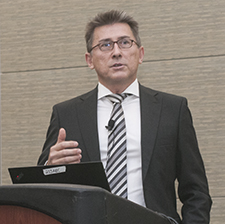The perioperative treatment of geriatric patients is a challenge because increases in frailty and comorbidities affect how the elderly react to anesthesia and the insult of surgery. Two speakers examined the effects of aging on patients and how to deal with them during Monday’s education session, “The Quick and Dirty on Anesthesia Care for the Complex Geriatric Patient.”
The elderly cardiac patient

Shamsuddin Akhtar, M.D., discusses the effects of aging on the cardiovascular system.
As patients age, their cardiovascular systems change and those changes affect the way they react to anesthesia. How the cardiovascular system changes and makes treatment more complex was examined by Shamsuddin Akhtar, M.D., Associate Professor of Anesthesiology and Pharmacology at Yale University School of Medicine.
One sign of cardiovascular aging is artery and vein remodeling, causing their stiffening, thickening, dilation and enlargement as well as endothelial and myocardial dysfunction. A second sign is inflammation, characterized by an increase in C-reactive proteins and the erythrocyte sedimentation rate, and the development of atherosclerosis.
Arterial stiffening in particular leads to increases in the aortic root size and wall thickness, pulse wave velocity, systolic blood pressure and pulse pressure. This combination of changes leads to arrhythmia, valvular disease, baroceptor dysfunction, heart failure and coronary artery disease.
These changes are inevitable, and lead to frailty and comorbidities. They make the care of elderly patients more complex.
“Frailty is a marker of neuromuscular degeneration,” Dr. Akhtar said. “On top of that, elderly patients are on multiple medications, so you have to deal with polypharmacy. Then we bring them into the operating room, and we expose them to anesthesia and surgery.
“This accentuates the complexity of these patients. Not one disease and one patient, but many diseases and many factors make them complex.”
These changes mean that anesthesia doses in elderly patients need to be adjusted from doses for younger patients, Dr. Akhtar said. A DrugPoint summary suggests that a geriatric anesthesia induction dose for propofol should be 20 mg I.V. every 10 seconds until induction onset.
“One thing to take away from this is that we are overdosing elderly patients,” he said. “We are decreasing doses, but not to the extent we should be.”
The result of overdosing is an increase in intraoperative hypotension, which is associated with poor outcomes. It also increases the risk of delirium. Studies have found that EEG suppression is an independent risk factor for postoperative delirium. Two ongoing studies could help with learning to prevent delirium. The studies are examining the impact 2 levels of anesthetic depth on outcomes after major surgery and the use of EEG-guided care versus routine care, Dr. Akhtar said.
To deal with the problems of anesthesia for elderly patients, Dr. Akhtar recommended:
- Avoiding preoperative medications
- Decreasing I.V. anesthesia doses by 50 percent
- Decreasing volatile anesthesia doses by 30 percent to 50 percent
- Avoiding the use of anticholinergics, antihistamines, tramadol and meperidine
- Using light sedation when possible
- Trying not to use neuromuscular blockers, which can delay recovery
Tools to implement tomorrow

Marek Brzezinski, M.D., Ph.D., explains actions anesthesiologists can implement quickly to improve outcomes.
Ongoing studies are looking at how to improve outcomes for elderly patients down the road, but anesthesiologists can take steps to improve outcomes immediately. Such steps include using good clinical judgment, optimizing patients and being proactive regarding renal and cognitive protection, said Marek Brzezinski, M.D., Ph.D., who also spoke at the session.
After age 50, organ function in patients begins to decline, and the decline becomes more rapid by age 80, said Dr. Brzezinski, Professor of Anesthesiology at the University of California, San Francisco.
Fluid management and organ perfusion are important in protecting the body’s organs, and goal-directed therapy was at one time thought to be a key step in hemodynamic optimization, he said. Studies, though, showed that arbitrary goals do not work as well as individual optimization.
On a positive note, the studies of goal-directed therapy showed it had other benefits, particularly with global oxygen delivery (DO2). Those studies showed that supra-normal DO2 resulted in better outcomes.
Perioperative renal dysfunction is a danger in the elderly, but steps can be taken to reduce the chances of acute kidney injury. There is no silver bullet for renal protection, Dr. Brzezinski said, but using magnesium and aspirin have been found to help circulation and have anti-inflammatory properties. Fenoldopam has been shown to be effective in controlling hypotension.
Dr. Brzezinski also addressed the issue of postoperative delirium, where data is too limited to draw good conclusions. One approach that has widespread support, though, is to use as little medication as possible.
“It is becoming clear that elderly patients really require less medication. If you reduce the depth of anesthesia in patients undergoing major surgery, you can reduce post-op delirium.”
Return to Archive Index